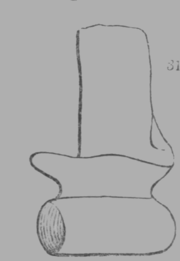lizards: their life is spent, principally, in the waters of rivers which communicate with the sea (Nile, Ganges, Senegal, Mississippi); and they sometimes pass from the shore to prey in the salt waters. Three great divisions of crocodiles correspond to three distinct physical regions:—the alligators are wholly American; the true crocodiles belong entirely to Africa and the West Indian islands; the gavials are found only in India. All the fossil races of crocodiles which occur in the saliferous and oolitic systems are analogous to the long snouted Indian gavials; those above the chalk approach the broader beaked Nilotic crocodiles.[1]
The vertebræ of palæosaurus and thecodontosaurus agree with those of ichthyosaurus and common fishes, in being deeply concave at each end—a structure evidently adapted for free motion in water. In a fossil crocodile from Sheppey they are concave anteriorly, and convex retrally. The former are really of ichthyoid, as distinguished from the latter, or truly crocodilian type; and, in a paper read to the Bristol meeting of the British Association, the discoverers of palæosaurus and thecodontosaurus (Riley and Stutchbury) proposed the speculation that the system of doubly concave vertebrae (fig. 30.) is more ancient than that of the concavo-convex (fig. 31.), and that the change from one to the

|

|
| Thecodontosaurus. | Crocodile. |
- ↑ Cuvier, Ossemens fossiles.
